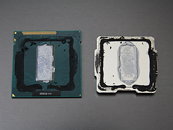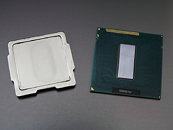Saturday, May 12th 2012

TIM is Behind Ivy Bridge Temperatures After All
It's proven: the thermal interface material (TIM) used by Intel, inside the integrated heatspreader (IHS) of its Core "Ivy Bridge" processors are behind its higher than expected load temperatures. This assertion was first made in late-April by an Overclockers.com report, and was recently put to test by Japanese tech portal PC Watch, in which an investigator carefully removed the IHS of a Core i7-3770K processor, removed the included TIM and binding grease, and replaced them with a pair of aftermarket performance TIMs, such as OCZ Freeze and Coolaboratory Liquid Pro.
PC Watch findings show that swapping the TIM, if done right, can shave stock clock (3.5 GHz, Auto voltage) temperatures by as much as 18% (lowest temperatures by the Coolaboratory TIM), and 4.00 GHz @ 1.2V temperatures by as much as 23% (again, lowest temperatures on the Coolaboratory TIM). The change in TIM was also change the overclockability of the chip, which was then able to sustain higher core voltages to facilitate higher core clock speeds. The report concluded that Intel's decision to use thermal paste inside the IHS of its Ivy Bridge chips, instead of fluxless solder, poses a very real impact on temperatures and overclockability.
Source:
PC Watch
PC Watch findings show that swapping the TIM, if done right, can shave stock clock (3.5 GHz, Auto voltage) temperatures by as much as 18% (lowest temperatures by the Coolaboratory TIM), and 4.00 GHz @ 1.2V temperatures by as much as 23% (again, lowest temperatures on the Coolaboratory TIM). The change in TIM was also change the overclockability of the chip, which was then able to sustain higher core voltages to facilitate higher core clock speeds. The report concluded that Intel's decision to use thermal paste inside the IHS of its Ivy Bridge chips, instead of fluxless solder, poses a very real impact on temperatures and overclockability.




219 Comments on TIM is Behind Ivy Bridge Temperatures After All
im intel for a min.
Im top of the pile for a few years with nehalem and sandybridge stomping my main competitor's best effort, 3 years in i bring out ivybridge which again increases performance JUST AS EXPECTED(by me) and actually very good(talking unlidded oc ability and raw IPC) , but their is no real reason at the minute to pass the consumer that much more and much to gain from holding a bit back ,ie performance per watt and lower Tdp's/ higher stock reliability and the knowledge that somethings in the back pocket for closeing season sales and smacking the competition back down, they put shit tim on, on purpose imho, as it was cheaper and kept the product within an envelope they liked(Tdp/temp) it is still better then sandy its just not the leap some expected
if all the Amd flamers had grown up and not slated them so much intel might now have a market competitor pushing them along still , but intel like me a chillin:pimp:
Am I the only one waiting for x79 Ivy Bridge Extreme with 8 cores of cpu sweetness with quad channel memory? :toast: :p
I do hope they use fluxless solder in these CPUs. :banghead:
Not likely but if the price is significantly higher as is the case with Sandy Bridge-E / LGA2011 with fewer options then you’re likely going to be among the few willing to pony-up for it. Actually the quad core Sandy Bridge-E Core i7 3820 is about ~$229.99 at Microcenter but most want the 6 core version Core i7 3930K at least.
I will point out I have seen no definitive evidence that Intel will upgrade the X79 / LGA2011 platform with Ivy Bridge-E. Even if they did Intel would likely upgrade the chipset to something like X89 given that they upgraded the prominent P67 / Z68 + line when they introduced Ivy Bridge.
The X79 chipset seemed rushed in order to get the Sandy Bridge-E line out in late 2011 and dropped a lot of expected features. So in retrospect the X79 chipset needs replacing more so then the current Ivy Bridge line needed it. Also since the Sandy Bridge-E / LGA2011 platform was supposedly the higher end option it has no business with a feature deficit with the lower-end (comparatively speaking) Ivy Bridge LGA1155 platform.
BTW, right now I have a Sandy Bridge-E Core i7 3930K / Asus P9X79 Deluxe and its a great platform. Intel Thunderbolt and native USB 3.0 would be nice though,.....
and your both backin intel whilst agreeing its a shit ocer at ambient temps and HSF cooled odd.
fair enough dude i know what your saying but imho its irelivant, to this thread,
If i were going to Oc with Ln2 , i would be very very happy intel put a shit removable tin lid on, as id remove it and strap my joy bucket straight to the chip..:laugh::slap:
but either way ^ghz does not impress no one when Amd cpus on silly scenarios go faster, and this is also irelivant i know..
to me these chips are perfectly as designed by intel, few more quids in their pockets ,imho they are happy sat on a bigger potential performance gain next gen due to clever tdp evaluation and validation
i wish some mofo would sort me a shot at Ln2 clocking id sweep records away i tell thee, i spend all my working days tuneing for performance on mass spectrometers, that and fixin em, i could do some damage im sure:p.
Well I do hope they come out with a revision, in a few months. I would like an Ivy bridge chip, and future overclockability is pretty important to me ! :)
Lulz, I'm rooting for a mayonaise upgrade. :roll:
EDIT: Actually, I didnt say that in THIS thread... :pRiiiiiiiiiiiiiiiight. Come get some... put your money where your mouth is and all that. It takes a more than you know (and I know for certain) to break records.
The "piledriver" will be the answer. Intel will give consumers an answer to this problem as well. A company worth 130.83 billion doesn't get there without making their customers happy.
I don't have problems with overheating, but I would like to try limits, that's why I have this idea. Any suggestion, please ?
Or I missing something, please tell me much more detail. Thank you.
And I think Dave has a cherry chip that's all :D
Tell me this, please, is there some differencies to AMD IHS or it's the same like on 3770K ? If the procedure got right, what I can expect, 10 degrees lower temperature on 4 GHz ?